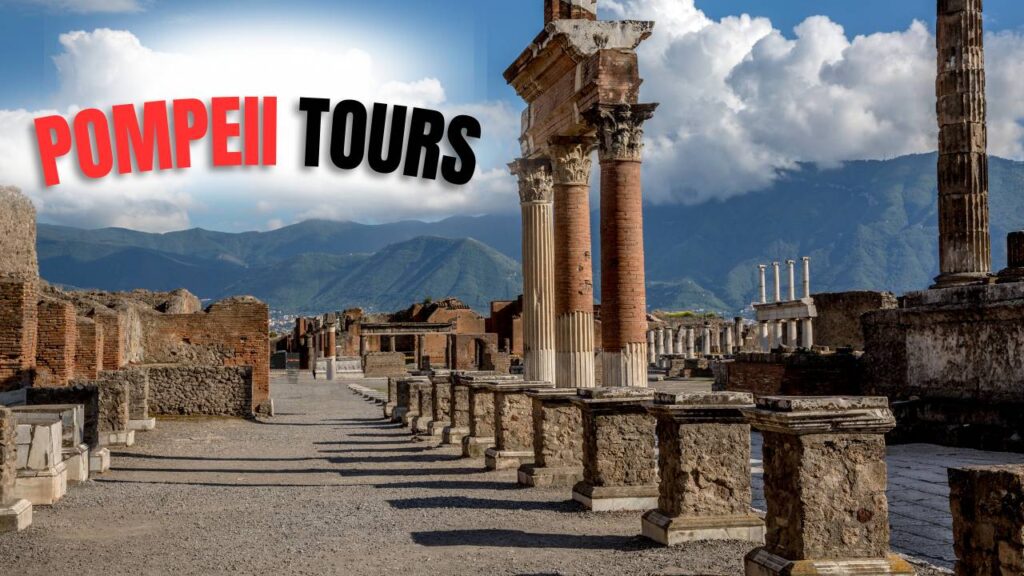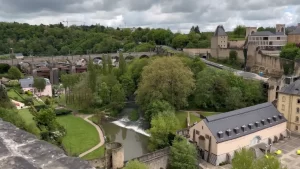Everything need to know about Pompeii Tours— from what to see and what to skip, to how to get there, when to go, and what to book in advance. Let’s get started!
Planning a trip to Italy? Add a destination that blends ancient history, stunning scenery, and real adventure to your itinerary—Pompeii Tours. This iconic archaeological site delivers one of the most unforgettable experiences in Europe. It welcomes all types of travelers, from history lovers and solo adventurers to families and couples, offering a powerful glimpse into the daily life of ancient Rome. As you walk Pompeii’s ancient streets, you uncover vivid frescoes, preserved ruins, and hidden alleyways that bring history to life.
When is the Best Time to Visit Italy? A Seasonal Breakdown
Pompeii Tours immerse you in a world frozen in time. Visiting grand villas, public baths, temples, and even bakeries, all remarkably preserved under layers of volcanic ash. This guide helps you navigate it all—showing you what to see, what to skip, and what to book in advance—so you can make the most of every moment and experience Pompeii like a pro.
Why Pompeii Is a Must-Visit for Every Type of Traveler
Pompeii, the ancient Roman city frozen in time by the eruption of Mount Vesuvius in 79 AD, offers a rare glimpse into daily life nearly 2,000 years ago. Unlike modern ruins, which often require imagination to reconstruct, Pompeii’s buildings, frescoes, streets, and even graffiti remain incredibly intact. For history lovers, it’s an open-air museum where every step takes you back in time.
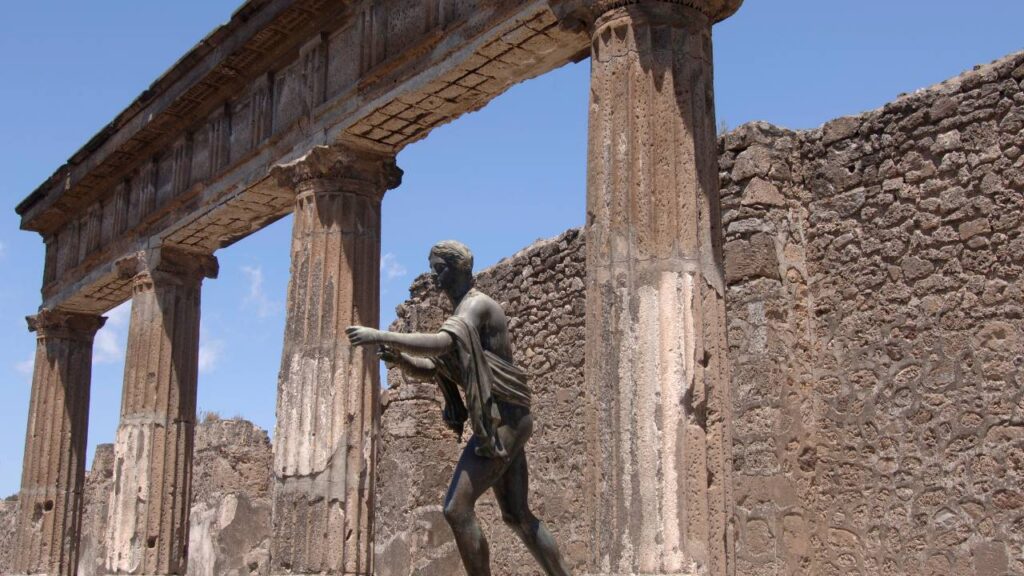
But Pompeii isn’t just for scholars. For families, it offers a real-life time machine that keeps kids engaged. For photographers and Instagrammers, the well-preserved architecture, dramatic ruins, and volcanic backdrop provide a breathtaking setting. Solo travelers and couples alike will appreciate the serenity and scale of this UNESCO World Heritage Site, which spans over 170 acres. Seeking educational value, scenic beauty, or a deeper understanding of ancient Roman life, Pompeii tours deliver an unforgettable experience.
How to Reach Pompeii from Rome, Naples, or the Amalfi Coast
Ancient ruins of Pompeii is a highlight for anyone visiting Italy. Preserved under layers of volcanic ash after the catastrophic eruption of Mount Vesuvius in 79 AD, this vast archaeological site offers a unique and haunting glimpse into life during the Roman Empire. Thanks to its accessible location in southern Italy, Pompeii is relatively easy to reach from major tourist centers like Rome, Naples, and the stunning Amalfi Coast. Below is a detailed and practical travel guide, offering you various options, estimated travel times, and important travel tips to make your visit stress-free and enjoyable.
From Rome to Pompeii
Distance: Approximately 240 km (150 miles)
Estimated Travel Time: Around 2 to 2.5 hours, depending on connections and waiting times
Traveling from Rome to Pompeii is quick and easy. Start at Roma Termini and take a high-speed train (Frecciarossa or Italo) to Napoli Centrale—about 1 hour 10 minutes. From there, follow signs to Napoli Garibaldi station (in the same building) and board the Circumvesuviana train to Pompei Scavi – Villa dei Misteri, which takes around 35 minutes. The ruins are just a 5-minute walk from the station. The full journey takes 2 to 2.5 hours, making a day trip possible. Booking high-speed train tickets in advance is recommended for better prices and guaranteed seats.
From Naples to Pompeii
Distance: Approximately 25 km (15 miles)
Estimated Travel Time: 30 to 40 minutes, depending on traffic and chosen transportation
If staying in Naples, the easiest and most economical way to reach Pompeii is by taking the Circumvesuviana train from Napoli Garibaldi station. The ride to Pompei Scavi – Villa dei Misteri takes about 35 minutes, and the station is just a short walk from the ruins. Taxis or private car transfers are available for a more comfortable ride, taking around 30 minutes but costing more. Buses are slower and less frequent, making the train the preferred option. For a more comfortable experience, try traveling mid-morning or early afternoon to avoid peak-hour crowds.
From the Amalfi Coast to Pompeii
Distance Varies by Town:
- From Sorrento: 26 km (16 miles)
- From Positano: 36 km (22 miles)
- From Amalfi: 50 km (31 miles)
- From Ravello: 48 km (30 miles)
Estimated Travel Time: 1.5 to 2.5 hours, depending on starting point, traffic, and transport mode
Reaching Pompeii from the Amalfi Coast requires a bit more planning. From Sorrento, take the Circumvesuviana train to Pompei Scavi – Villa dei Misteri, a 30-minute ride. If you’re in Positano, Amalfi, or Ravello, take a SITA bus to Sorrento first, which can take 1 to 1.5 hours, and then catch the train. Alternatively, guided tours or shuttle transfers from the Amalfi Coast offer a more convenient, though pricier, option. Driving is possible, but traffic along the coast can be slow, and parking near Pompeii can fill up quickly. Start early to avoid delays, especially during peak season.
When to Visit Pompeii: Best Times, Worst Times & Weather Tips
Pompeii is open year-round, but the timing of your visit can greatly influence your experience.
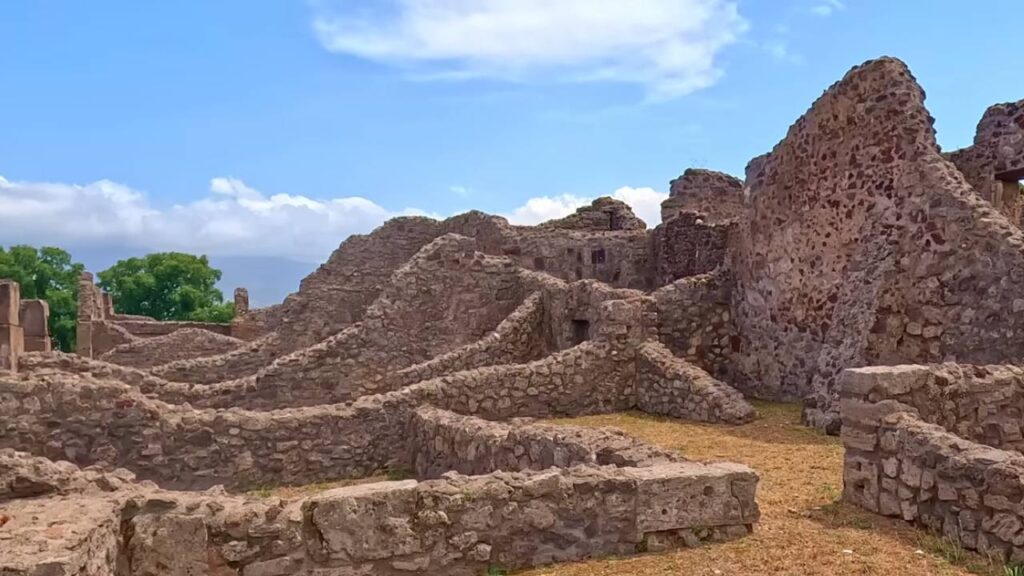
Best Times to Visit Pompeii
Optimal Months: April to June & September to Early November
Pompeii is an iconic destination open to visitors year-round, but timing your visit can greatly impact your experience. The best months to visit the ruins are during the shoulder seasons, which fall between April to June and September to early November. These months offer ideal weather conditions, fewer crowds, and a more enjoyable experience for those wanting to delve into Pompeii’s fascinating history without the hassle of long lines or extreme heat.
Why April to June?
The spring months, from April to June, are considered the perfect time to visit Pompeii due to the pleasant weather and manageable crowds. As temperatures begin to rise, the climate is still mild—ideal for outdoor exploration. Average temperatures during these months hover between 60°F to 80°F (15°C to 27°C), which is comfortable for walking and touring the sprawling archaeological site.
The spring bloom around Pompeii and the surrounding areas adds an extra layer of beauty to the landscape. The lush greenery surrounding the ruins provides a stark contrast to the stark stone structures, and flowers begin to bloom, creating picturesque scenes perfect for photography. This period also marks the start of the high tourist season, but crowds are not as overwhelming as in the summer months, allowing for a more peaceful experience.
Why September to Early November?
September to early November is another excellent time to visit, as temperatures start to cool down from the summer heat while still remaining pleasant for sightseeing. September especially has mild weather, with average temperatures ranging from 70°F to 85°F (21°C to 29°C). As the month progresses into October and November, the weather becomes even more comfortable, with cooler mornings and evenings but still plenty of sunshine during the day.
This time of year also brings golden-hour lighting, which is perfect for those keen on photography. The warm, soft hues at sunset add an ethereal quality to the ruins, making it an ideal time for capturing the ancient structures with dramatic backdrops. Moreover, the fall months are a lot quieter than the peak summer season, which means less crowded paths and a more relaxed pace when exploring Pompeii’s highlights.
Worst Times to Visit Pompeii
Avoid July and August
While Pompeii is open year-round, there are times when the experience can become uncomfortable and overwhelming, particularly during the hottest months of the year. July and August are the worst times to visit, and here’s why:
Why July and August Aren’t Ideal:
The summer months in Pompeii can be sweltering, with temperatures often exceeding 90°F (32°C), and at times even soaring past 95°F (35°C). As Pompeii is an open-air archaeological site with minimal shade, the exposure to direct sunlight can make the heat feel even more intense. The lack of shaded areas, combined with the high temperatures, can quickly lead to dehydration or exhaustion, especially for those not accustomed to the Mediterranean heat. For those planning to visit in the summer, it’s important to be prepared for the heat.
July and August coincide with the peak tourist season, meaning that the site will be more crowded than usual. You’ll encounter long lines at ticket booths, at the entrance, and potentially at various key sites within the ruins. The combination of high temperatures and large crowds can make the experience overwhelming, particularly if you’re planning to visit Pompeii during the middle of the day when the sun is at its peak.
If you do decide to visit in the summer, it’s highly advisable to go early in the morning or late in the afternoon to avoid the worst of the heat and crowds. Midday visits should be avoided entirely, as the temperature will be at its highest and the site will be crowded with other tourists.
Why Winter (December and January) Can Be Challenging:
Another less-than-ideal time to visit Pompeii is during the winter months, particularly December and January. While temperatures tend to be cooler and milder compared to the summer, averaging between 40°F to 60°F (4°C to 16°C), the weather can be unpredictable, and rain is more frequent. Exploring the ancient ruins on a rainy day can make the experience much less enjoyable due to muddy paths, slippery cobblestones, and an overall damp atmosphere.
Some of the services and shops around the archaeological site may be limited or closed during the off-season. While the crowds are generally smaller during these months, the rainy conditions can still make it difficult to fully enjoy the ruins, especially if you’re not prepared with appropriate rain gear. If you’re planning to visit in winter, be sure to check the forecast beforehand and prepare for possible wet weather.
Weather Tips for Visiting Pompeii
No matter when you visit, it’s essential to be prepared for Pompeii’s varied weather conditions, particularly if you are touring during the hotter months or in unpredictable weather.
Preparation for Warm Weather:
- Stay Hydrated: Temperatures in Pompeii can get extremely hot, especially in the summer months. Always bring a reusable water bottle to stay hydrated. There are several fountains throughout the archaeological site where you can refill your water bottle for free, so take advantage of these facilities to avoid dehydration.
- Wear Sun Protection: The sun can be quite harsh in Pompeii, particularly during the summer months when the temperature regularly reaches high levels. Wear a wide-brimmed hat to protect your face from the sun, and apply sunscreen generously to exposed areas of your skin. Reapply sunscreen throughout the day, especially after sweating or visiting water sources.
- Dress Appropriately: Since Pompeii involves a lot of walking on uneven surfaces, it’s important to wear comfortable, sturdy footwear. Make sure your shoes have a good grip to navigate the cobblestones and uneven terrain without slipping. Avoid sandals or open-toed shoes as they can leave your feet vulnerable to injury. Additionally, lightweight breathable clothing is essential in hot weather to keep you cool.
- Plan for Shade: Try to stay in the shaded areas around the ruins, and take breaks whenever possible. If you’re traveling in the summer, it’s best to visit in the morning or late afternoon, when the sun is less intense.
Preparation for Rainy Weather:
- Check the Forecast: Before heading to Pompeii, always check the weather forecast to make sure you’re prepared for any inclement conditions. Even in the milder months, rain can occasionally disrupt your plans.
- Bring a Poncho: In case of rain, a lightweight poncho or waterproof jacket is more practical than an umbrella. The narrow pathways and uneven cobblestones can make using an umbrella cumbersome and potentially dangerous. A poncho will keep you dry while allowing you to move freely through the site.
- Consider Footwear: Waterproof sturdy shoes or boots are recommended if there’s a chance of rain. Wet, muddy paths can become slippery, and you’ll want to ensure your footwear provides adequate grip and protection from the rain.
Things to Do in Lecce: Must-See Attractions and Local Secrets
What to See in Pompeii: Must-Visit Highlights and Hidden Places
There’s so much to see in Pompeii that you could spend an entire day and still not cover it all. Here are the highlights and a few hidden places:
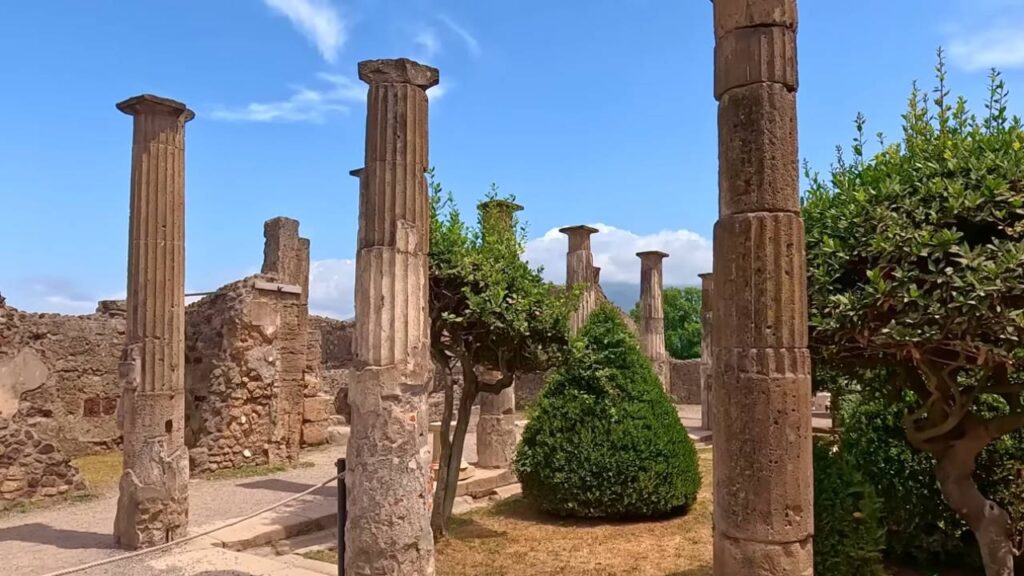
Must-Visit Highlights in Pompeii
1. The Forum
The Forum served as the bustling heart of public life in ancient Pompeii. Surrounded by temples, public buildings, and marketplaces, this spacious area was a central hub for political speeches, civic meetings, and religious ceremonies.
Key structures around the Forum include:
- The Temple of Jupiter, a grand structure dedicated to the Roman god, showcasing intricate carvings and towering columns.
- The Basilica, where Pompeii’s citizens conducted legal and commercial affairs.
- The Curia, where political leaders met to discuss important matters.
Visitors can immerse themselves in the energy of this public space and imagine how ancient Pompeiians interacted here, surrounded by significant structures that reflect the city’s civic and spiritual life.
2. The Amphitheatre
The Amphitheatre stands as one of the oldest surviving Roman amphitheaters, dating back to 80 BCE. It is remarkably well-preserved, allowing visitors to experience the grandeur of Roman entertainment. This arena once hosted gladiator contests, mock naval battles, and other public spectacles.
With a seating capacity of 20,000, the amphitheater was an engineering marvel of its time. It provided a view of the intense spectacles in the arena and offered a fascinating glimpse into the bloodthirsty nature of Roman entertainment. The structure’s design, including its advanced acoustics, remains impressive and is a testament to Roman ingenuity.
3. The House of the Faun
The House of the Faun is one of the largest and most luxurious homes in Pompeii. This sprawling villa is famous for its mosaics, including the Alexander Mosaic, which depicts the dramatic Battle of Issus between Alexander the Great and King Darius III of Persia.
This house features grand courtyards, stunning frescoes, and beautiful gardens that highlight the wealth and sophistication of its owners. The mosaics and frescoes provide a visual story of Roman life and the cultural appreciation of art and architecture in Pompeii.
4. Villa of the Mysteries
Located outside the city walls, the Villa of the Mysteries is renowned for its frescoes depicting Dionysian rituals. These incredibly detailed paintings portray the initiation rites into the cult of Dionysus, the god of wine and ecstasy.
The villa offers visitors a glimpse into Roman religious practices, showcasing vibrant and well-preserved artwork that reflects the culture of the time. Its location slightly away from the main tourist paths makes it a quieter, more contemplative experience for those interested in the spiritual life of Pompeii.
5. The Lupanar
The Lupanar is Pompeii’s most famous brothel, located in a quieter part of the city. Visitors will find frescoes on the walls depicting various sexual acts, likely serving as advertisements for the services offered within.
The brothel’s small rooms, each with stone beds, reveal a different side of Pompeian life, offering a stark contrast to the grander public and private buildings in the city. Despite the discomforting subject matter, the Lupanar provides a fascinating look at the more private aspects of daily life in Pompeii.
6. Stabian Baths
The Stabian Baths are one of the most well-preserved examples of public Roman baths in Pompeii. These baths were more than places to wash—they were places of relaxation, socialization, and exercise.
The Stabian Baths feature sophisticated heating systems, including hypocausts (underground heating), allowing the Romans to enjoy varying temperatures in the cold, warm, and hot rooms. The intricate mosaics and frescoes found inside depict scenes of everyday life, further showcasing the importance of the baths in Roman society.
7. The Garden of the Fugitives
The Garden of the Fugitives is one of the most moving places in Pompeii. Here, visitors can see plaster casts of victims who died during the eruption of Mount Vesuvius in 79 CE. The casts, formed from the spaces left in volcanic ash, capture the victims in their final moments as they attempted to escape the eruption.
The garden, with its lush greenery and peaceful setting, contrasts sharply with the tragic figures frozen in time. These casts give visitors a deeply human connection to the catastrophic events that destroyed Pompeii.
Hidden Places of Pompeii
1. House of the Vettii
The House of the Vettii, recently reopened after extensive restoration, is one of the best-preserved homes in Pompeii. Visitors can enjoy the beautifully adorned house, which is filled with vivid frescoes showcasing mythological scenes and daily life in Pompeii.
This home belonged to two wealthy merchants, and it provides a window into the lives of Pompeii’s elite. The frescoes and mosaics are not only artistic masterpieces but also serve as a record of the social status and tastes of the owners.
2. Temple of Isis
The Temple of Isis is dedicated to the Egyptian goddess Isis, reflecting the influence of Egyptian religion in Pompeii during the Roman period. The temple’s frescoes and statues reveal the significant role that foreign gods played in the city’s religious life.
Visiting this well-preserved temple allows you to experience the intersection of Egyptian and Roman cultures and see firsthand the diverse spiritual practices that shaped Pompeii.
3. Street of Tombs
The Street of Tombs lies on the outskirts of Pompeii and offers a glimpse into ancient Roman burial customs. The road is lined with mausoleums, monuments, and tombs, many of which feature elaborate carvings and inscriptions.
Reggio Calabria Travel Guide: Best Time, Food & Must-See Places
Walking along this quiet street gives insight into how Pompeiians commemorated their dead, with tombs designed to honor the wealth and status of the deceased. The tombs’ architectural styles reflect the Roman belief in the afterlife and offer a peaceful setting for reflection.
What to Skip: Common Tourist Traps & Time-Wasters in Pompeii
Pompeii is a remarkable archaeological site, brimming with history and fascinating insights into the past. However, not everything within the ruins is worth your time. When you visit this ancient city, prioritize what’s truly valuable to your experience. Below are some common tourist traps and time-wasters you should skip, especially if you’re short on time.
1. Skip Generic Souvenir Shops Near the Entrance
You’ll encounter numerous souvenir shops as soon as you enter Pompeii. While it’s tempting to pick up a trinket or keepsake, most shops near the entrance sell overpriced, low-quality items that are mass-produced. You’ll find cheap ceramic replicas, low-quality mosaics, and generic t-shirts that don’t reflect the essence of Pompeii’s rich history.
Instead of buying souvenirs inside the site, head to nearby cities like Naples or Sorrento, where you can find unique, locally-made items that showcase authentic Italian craftsmanship. These shops offer better prices and more meaningful mementos. Plus, you’ll support local artisans and businesses.
2. Avoid Restaurants Inside the Pompeii Site
Inside Pompeii, you’ll find cafeterias and small eateries that cater to tourists. While convenient, these spots are usually crowded, overpriced, and lack quality. The food is basic, and the options are limited, designed to serve large crowds rather than provide an authentic Italian dining experience.
Instead of eating inside the site, nearby towns such as Naples, Sorrento, or Herculaneum, where you’ll find diverse restaurants offering fresh, local Italian dishes. If you’re pressed for time, pack a light lunch and enjoy it in one of the quieter spots within the park. This way, you’ll avoid the crowds and still enjoy Pompeii’s beauty while dining.
3. Don’t Use Audio Guides from Outside Vendors
While audio guides might seem convenient, many third-party vendors outside the site offer outdated, inaccurate, and sometimes incomplete guides. These guides might not reflect the latest research or omit key details, leading to a less informative visit.
For a more reliable experience, use the official guides provided by Pompeii Archaeological Park. You can also download their app, which offers updated and accurate self-guided tours. If you prefer a more in-depth experience, hire a licensed guide or join a well-reviewed tour group. A knowledgeable guide will help you navigate the site and provide expert insights into Pompeii’s fascinating history.
4. Skip Over-Touring the Smaller, Less Significant Areas
Pompeii covers over 160 acres, and while you may want to see everything, some parts of the site are less significant. Smaller homes, minor temples, or residential areas might not add much to your overall experience compared to Pompeii’s most iconic attractions.
To make the most of your time, focus on the must-see highlights like the Forum, the Amphitheatre, the House of the Faun, and the Villa of the Mysteries. These sites offer the best insights into Pompeii’s grandeur and history, making them a better use of your time than wandering through less remarkable sections of the ruins.
5. Don’t Visit Without Proper Planning
Pompeii is vast, and without some planning, you could waste valuable time getting lost or trying to figure out what to see next. The site can also become crowded, especially during peak tourist seasons, making it harder to navigate through the crowds and get to the main attractions.
Plan ahead by bringing a guidebook or using a Pompeii app for a self-guided tour. To avoid wasting time, allocate 3-4 hours for your visit, or even more if you want to dive deeper into the site’s history. Arrive early in the morning, especially during the summer months, to beat the crowds and the heat. This way, you can enjoy Pompeii in peace while gaining a deeper understanding of its ancient wonders.
What to Book in Advance: Tickets, Guided Tours & Transportation
Booking aspects of your Pompeii visit in advance can significantly improve your overall experience, saving you both time and stress. Not only does it guarantee you access to the site, but it also offers the convenience of avoiding long queues and securing the best tours. Here’s a breakdown of what you should consider booking ahead of time for a smooth and enjoyable visit to Pompeii.
Tickets: Avoid Long Lines and Save Time
1. Standard Entry Tickets:
The Pompeii Archaeological Park offers a simple online booking option for standard entry tickets. By purchasing your tickets in advance on the official website, you can avoid the long queues at the entrance. This is particularly important during peak tourist seasons (April to October) when lines can stretch for hours. The entry ticket typically grants access to the main archaeological site, including all major highlights.
2. Skip-the-Line Tickets:
Visiting during the high season or on a busy weekend, it’s highly recommended to opt for skip-the-line tickets. These special tickets allow you to bypass the standard entry lines, saving you valuable time. With skip-the-line tickets, you’ll have quicker access to the site, giving you more time to enjoy the ruins at your own pace. Booking skip-the-line tickets is especially beneficial during the summer months or when there are cruise ships in port, as the area can get quite crowded.
3. Discounts for EU Citizens:
EU citizens under the age of 18 and over the age of 65 often enjoy free or discounted admission. It’s advisable to bring valid identification with you to claim these discounts. For other visitors, the entrance fee is generally affordable, but for those who want to skip the line and avoid potential delays, it’s worth investing in the skip-the-line option.
Guided Tours: Gain a Deeper Understanding of Pompeii’s History
Pompeii is a vast and complex site, so a guided tour can help you make the most of your visit by providing context and details that you might miss on your own. There are a variety of tours available, catering to different interests, group sizes, and budgets.
1. Classic Guided Tours:
Visiting Pompeii for the first time, a classic guided tour is an excellent option. These tours typically last around 2–2.5 hours and cover the main highlights of the site, including the Forum, the Amphitheatre, and the House of the Faun. The guides are knowledgeable and offer engaging narratives that will bring Pompeii’s fascinating history to life. Classic tours are great for those looking for an overview of the site’s significance.
2. Archaeologist-Led Tours:
For history enthusiasts, archaeologist-led tours provide an in-depth experience. These tours go beyond the surface-level facts and delve into the intricate details of Pompeii’s daily life, its architectural marvels, and the ongoing archaeological work that continues to uncover the city’s secrets. Archaeologists leading these tours offer expert insights into the history and excavation of the site, making them ideal for visitors who want a deeper understanding of Pompeii’s past.
3. Family Tours:
Visiting with children? A family-friendly tour could be the best option. These tours are designed to engage younger visitors with interactive experiences, making the history of Pompeii fun and educational. Kids can participate in activities, listen to engaging stories, and the ruins in a way that keeps them interested and entertained. Family tours usually have a shorter duration, ensuring that younger children don’t get tired or overwhelmed.
4. Private Tours:
For more personalized experience, a private tour is the way to go. These tours allow you to tailor your route, duration, and specific interests. Whether you want to visit Pompeii’s lesser-known areas or delve deeper into certain aspects of the site, a private guide can accommodate your preferences. With one-on-one attention, you’ll receive a more intimate experience, and your guide can answer all your questions in real time.
5. Combo Tours:
To visit more than just Pompeii, combo tours are a great option. These tours combine Pompeii with nearby attractions such as Herculaneum, Mount Vesuvius, or even the Amalfi Coast. Combo tours are ideal for those with limited time who want to maximize their visit to the region. For example, after exploring Pompeii, you could head to the summit of Mount Vesuvius and take in panoramic views of the Bay of Naples, all in the same day. Combo tours usually include transportation and a guide, making the experience seamless and efficient.
You can book these tours through trusted platforms like GetYourGuide, Viator, or directly with local tour companies. It’s recommended to book at least a week in advance, especially if you’re traveling during peak seasons, to ensure availability and get the best prices.
Transportation: Choose the Right Option for Comfort and Convenience
If not familiar with the area or are uncomfortable using public transit, booking transportation in advance will save you time and hassle. There are several convenient transportation options to consider for getting to Pompeii.
Private Shuttles or Round-Trip Transfers:
For the ultimate convenience, consider booking a private shuttle or a round-trip transfer through a tour operator. Many local operators offer door-to-door service from nearby cities such as Naples, Sorrento, or even the Amalfi Coast. These services often include hotel pick-up and drop-off, so you don’t have to worry about navigating the public transport system or finding your way to the site. Private transfers are ideal for families, groups, or those seeking a more comfortable and stress-free experience.
Public Transit with Added Comfort:
If comfortable using public transport but prefer a more structured experience, some tour operators offer transportation packages that combine public transit (like the Circumvesuviana train) with a guided tour. These packages often include transportation to and from Pompeii, plus a knowledgeable guide, all for one price.
Car Rentals:
If you prefer to drive, renting a car is also an option. Renting a car offers flexibility, allowing you to visit Pompeii at your own pace and visit other nearby attractions, such as Herculaneum or Mount Vesuvius, without relying on public transport. Keep in mind that parking near Pompeii can be challenging, especially during peak tourist seasons. You’ll find parking lots near the entrance, but they can fill up quickly. Be sure to check availability and plan accordingly if you choose this option.
Things to Do in Amalfi Coast: Top Picks & Travel Tips
Pompeii is not just a destination; it’s a journey through history that will leave a lasting impact on any traveler. Prepare well, and step into the past like never before.
FAQs
1. What is the best time to visit Pompeii?
The best time to visit Pompeii is during the spring (April to June) or fall (September to October) when the weather is mild and the crowds are smaller. Summer can be hot and crowded, so visiting early in the morning or later in the afternoon helps avoid the midday heat.
2. How long does a Pompeii tour take?
A typical Pompeii tour lasts around 2 to 3 hours. However, if you’re exploring on your own or with a more in-depth guide, it can take longer.
3. Do I need to book Pompeii tickets in advance?
Yes, it’s recommended to book Pompeii tickets in advance, especially during peak seasons (spring and summer) to avoid long lines. Booking in advance can also save money.
4. Is Pompeii wheelchair accessible?
Pompeii is partially wheelchair accessible, but it can be challenging due to the uneven terrain. Some areas, like the main streets and certain buildings, are more accessible, but many paths and ruins are uneven or require stairs.
5. What should I wear for a Pompeii tour?
Wear comfortable walking shoes, preferably closed-toe, as the site has uneven surfaces. It’s also a good idea to dress in layers and bring a hat and sunscreen, especially in the summer.
6. Are there guided tours of Pompeii?
Yes, guided tours are available in multiple languages. Professional guides can provide historical context and deeper insights into the ruins, helping you make the most of your visit.
7. Can I visit Pompeii on a day trip from Rome or Naples?
Yes, Pompeii is easily accessible from both Rome and Naples. The journey takes around 2 to 2.5 hours from Rome and about 30 minutes from Naples by train.
8. Is Pompeii safe to visit?
Yes, Pompeii is a safe destination for tourists. However, like in any busy tourist area, it’s essential to keep an eye on your belongings, especially in crowded spots.
9. Are there any other sites to see near Pompeii?
Yes, you can visit Mount Vesuvius, the volcano that destroyed Pompeii, and Herculaneum, another ancient Roman city that was also buried by the eruption.
10. Can I take photos at Pompeii?
Yes, photography is allowed at Pompeii, but drones are prohibited without special permission. Make sure to respect the site and not disturb any artifacts.
